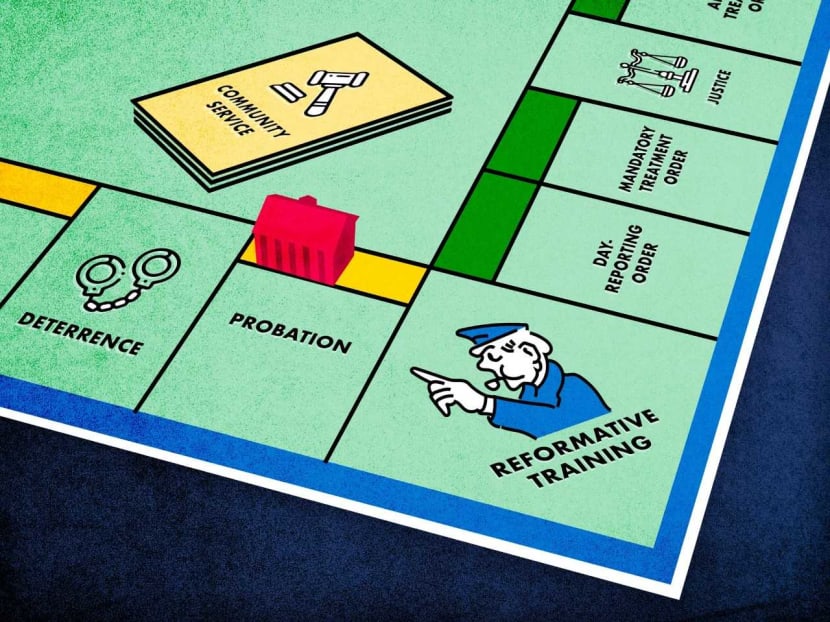Explainer: What are community-based sentences and other punishments besides jail?
SINGAPORE — After National University of Singapore dentistry student Yin Zi Qin’s community-based sentences for choking his girlfriend made headlines over the past week, some members of the public had one burning question: Why not jail time?

Judges may consider a range of sentencing options other than jail, depending on the facts of the case, the profile of the offender, and other factors.
- The case of dentistry student Yin Zi Qin sparked some criticism because he was not jailed
- Judges have a range of sentencing options other than jail that they can consider, depending on the case
- Community-based sentences are used for less serious crimes
- Each sentence is governed by a range of factors including the facts of the case and the profile of the offender
SINGAPORE — After National University of Singapore dentistry student Yin Zi Qin’s community-based sentences for choking his girlfriend made headlines over the past week, some members of the public had one burning question: Why not jail time?
TODAY explains the factors and considerations that go into the final sentencing decision, as well as the different sentences that offenders can receive.
While deciding on the appropriate sanction, a court is guided by four principles: Retribution, deterrence, prevention and rehabilitation.
Community-based sentences are those that combine punishment with rehabilitation. Once an offender — who must be aged above 16 — successfully completes serving them, they will not have a criminal record.
Judges were first given leeway to impose such sentences in 2011 for less serious crimes such as theft or mischief. Offenders can be given a combination of such sentences.
In October 2018, the eligibility criteria for community-based sentences were expanded after the Criminal Justice Reform Act 2018 was passed in Parliament.
Now, more types of offenders — such as those who previously served short prison stints of up to three months — can be given a community-based sentence.
Courts can also impose a “suspended” jail sentence, in conjunction with a community-based sentence. This jail time will automatically take effect if an offender breaches his community-based sentence.
Former Attorney-General V K Rajah had remarked in 2016 that community-based sentences were “under-utilised”, suggesting that more offenders who commit less serious crimes could make amends for their wrong-doing through this form of sentencing as an alternative to harsher punishment.
In general, courts also consider other factors during sentencing.
These include similar past cases, the prescribed punishment for the offence, whether an offender is remorseful or has a previous criminal record, and whether restitution or compensation has been made.
Judges are guided by the prosecution and defence, who will each argue for the sentences they think appropriate.
YIN ZI QIN’S CASE
Yin’s sentencing triggered a public outcry and an announcement by Home Affairs and Law Minister K Shanmugam on July 21 that a review would be held to look into the penalty framework for violent cases.
In the case, District Judge Marvin Bay found that Yin’s relative youth, rehabilitative prospects and lack of previous convictions made a community-based sentence a viable option.
Yin, 23, was handed a 12-day short-detention order, a five-month day-reporting order, as well as 80 hours of community service. The judge also said he was satisfied that Yin "is not at high risk of reoffending”.
The Attorney-General’s Chambers, which had sought 14 days’ detention coupled with a community service order and a day-reporting order, said that it will not be appealing against the sentence.
So, what are the various types of community-based sentences and other punishments, besides the traditional jail and fine?
1. Short-detention order
Offenders will serve time behind bars for up to two weeks, but will have no criminal record when released.
Judges will consider the circumstances, including the nature of the offence and the offender’s character, before imposing it.
The sentence is deterrent in nature and allows offenders to experience the “short, sharp, shock” of prison life, based on a guidebook produced by the State Courts for accused persons.
Those who have received a short-detention order include:
Hoon Qi Tong, a Singapore Management University graduate who filmed his female colleague in the toilet
Nicholas Ting Nai Jie, a teenage e-scooter rider who collided into a housewife and caused her to suffer severe brain injuries
A 49-year-old woman who slashed her daughter’s arm while trying to chop up their family dog
2. Day-reporting order
Offenders will have to report to a day-reporting centre for monitoring, counselling and to undergo rehabilitation programmes. The period can range from three to 12 months. The offenders may also be electronically monitored.
Some who have received the sentence are:
Yeo Wee Soon, who killed his pet poodle while trying to clean and discipline it
Jasmine Lau Jie Min, a teenager who repeatedly harassed her neighbour until he moved out of his apartment
3. Mandatory treatment order
This is imposed on offenders suffering from a treatable psychiatric condition that contributed to their offences. They will have to go for treatment with a court-appointed psychiatrist for up to three years.
Some who have received the sentence include:
Christina Cheong Yoke Lin, who scammed a love scammer before being scammed herself
Lennard Harold Thean See Yin, a top eye specialist who tailgated another car and threw a wine bottle at it
Sophia Ong Daijuan, who abused her pet chihuahua to death
4. Community service order
Offenders have to perform supervised community service for them to make amends to the community. Courts will look at the mental and physical conditions of an offender and whether it will allow for his or her reformation.
5. Community work order
Offenders have to perform unpaid community work associated with the offence committed, under an officer’s supervision.
OTHER SENTENCES
Probation
This is usually handed to offenders aged below 21 but older adult offenders can receive it if found appropriate, such as if they show an extremely strong propensity for reform.
Offenders will be supervised by a probation officer for between six months and three years. They have to adhere to the probation conditions, such as curfews and community service requirements. If they do not, they can be jailed or fined instead.
The rehabilitative sentence allows offenders to remain out in society and carry on their daily activities.
Reformative training
This is a more serious punishment than probation for young offenders who commit relatively serious crimes. They have to go through a regimented rehabilitation programme at a reformative training centre for a minimum period of six or 12 months.
Corrective training
It is a more serious form of imprisonment imposed when a court finds an offender needs training of a corrective character for a substantial period. It usually lasts between five and 14 years.
Offenders must be older than 18, have been imprisoned before and certified fit for corrective training.
Preventive detention
This is a severe punishment for recalcitrant offenders who the courts think should be locked away to protect the public from them. They will be put away for at least seven years and for a period of up to 20 years.
Offenders must be aged above 30, previously imprisoned and certified fit for preventive detention.








